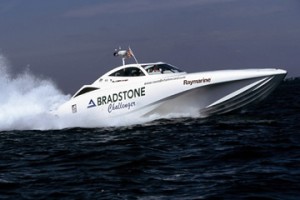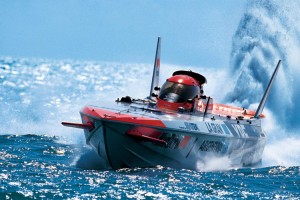 I recently had the pleasure of talking to a Financial Times reporter about Iran’s appetite for small boats. The story, dealing with the saga of the “Bradstone Challenger“, a Bladerunner 51 speedboat, just hit the press today (and it got some love from Drudge (bottom middle column), so…good times). (.pdf here)
I recently had the pleasure of talking to a Financial Times reporter about Iran’s appetite for small boats. The story, dealing with the saga of the “Bradstone Challenger“, a Bladerunner 51 speedboat, just hit the press today (and it got some love from Drudge (bottom middle column), so…good times). (.pdf here)
I noted Iran’s interest in the Ice Marine’s Bladerunner back in early 2009–in fact, I reported the Commerce Department’s “stop order”, coming on January 22, was one of the Obama Administration’s first actions taken after the inauguration. But, sadly, bureaucracy intervened–South Africa mislaid the order, sending the boat off in the “Iranian Diplomat.”
“The loading went ahead because, said one source, no one saw the US notice sent by fax over a weekend. US special forces were ready to intercept the Iranian merchant vessel but the operation was called off, the source said.”
Oy. So now the vessel has, reportedly, been militarized (or, more likely, is being reverse-engineered).
The Bladerunner saga has a lot of interesting loose ends.
First, Why would Iran focus on getting a high-profile vessel from South Africa, when, Ice Marine has a Bladerunner dealership in Dubai? Wouldn’t a quick, underhanded cross-Gulf transfer be easier? And…wouldn’t a quick n’ dirty local “purchase” have avoided a lot of fuss over export documents?
At the time, I thought there was some yellowcake smuggling going on.
I was wrong. Reports vary, but it seems the Iranians wanted this particular model–apparently the craft, the record-holding “Bradstone Challenger” is endowed with few more bells and whistles than your average “off the shelf” commercial Bladerunner 51. If true, this suggests Iran is continuing to invest a lot of energy (and commit their globe-spanning “grey” networks) towards obtaining small, fast craft. The Bradstone Challenger went though several hands–and across half the globe–before overt Iranian agents finally acquired of the vessel.
Second, Iran’s Bladerunner acquisition may suggest that Iran isn’t entirely happy with the North Korean, Chinese, Swedish (Boghammar), Italian (of a type similar to the pic below), French and, well, UK and U.S. “patrol craft” designs it already has access to. With the bulk of the Iranian fast-boat Navy made up of North Korean and Chinese small ship designs, Iran may be looking for a smoother-riding fast boat that might make a better weapons platform.
Third, this story comes out of Rome. That, in itself, is fascinating because Iran got it’s last batch of advanced speedboat designs from–you guessed it–Italy! Here’s a January 2010 Wall Street Journal quote:
“The paramilitary security forces purchased frame and design plans of the patrol boat “Levriero” from the Italian company FB Design in 1998. When Italian
media reported this and other business deals the company has made with the Iranians, FB Design’s founder and owner, Fabio Buzzi, was surprisingly frank. “It’s true, it’s not a mystery, I sold boats and technology to the Iranians,” he told ANSA in 2008. “We regularly sold design and technology to the Iranian secret services,” he admitted. Mr. Buzzi said in the same interview that he stopped his Iran business only after U.S. officials questioned him in 2005 about his supplies to the Revolutionary Guard.
Citing Pentagon sources, Emanuele Ottolenghi writes in his 2009 book “Under a Mushroom Cloud—Europe, Iran and the Bomb,” that Iranian-made copies of the FB Design Levriero were part of the Revolutionary Guard speedboats that seemed bent on provoking a confrontation with three U.S. warships two years ago. In January 2008, in the Strait of Hormuz, these boats sailed too close to the American vessels and made threats over the radio.”
The Obama Administration is clearly irked:
“The sturdy link between Italy and Iran has also irked the Obama administration. When asked about Rome’s dealings with Tehran, David Thorne, U.S. Ambassador to Italy, told reporters after taking office two months ago that “there are certain Italian foreign policy positions which continue to concern us.”
So we might be seeing an effort to tweak the U.S. a little bit.
And finally, there’s a potential political edge here. A little Hawaiian company called Navatek (I talked about these guys last year) is peripherally involved in Bladerunner 51 development (Navatek is reportedly making a patrol version).
Given that Navatek is a regular recipient of earmarks from Hawaii’s Democratic Senator Daniel Inouye (and Navatek is, naturally, a big Inouye donor), Iranian acquisition of this company’s technology might make for some interesting political theater. Senator Inouye is up for re-election this year.
So with all that backstory…Let’s return and examine the fundamental strategic question: Just how big a danger are Iran’s little boats? Should the U.S. worry?
Not really.
Surprise aside (a la the USS Cole), the small boat “record” since World War II fails to live up to modern-day hype. Certainly, small boats are not things to ignore, but I have serious doubts about the risk a small boat swarm poses to a prepared U.S. warship. And, in the article, I said so:
“Though the US Navy is very concerned a swarm of small boats can overwhelm and sink a large warship, the hypothesis is untested. It has never been done,” Mr Hooper told the FT. “A small, fast boat navy is nothing more than a surprise strike and harassment force. Every time small, fast boats run into helicopters, the helicopters win.”
To be blunt, the
proof just ain’t there. Once a fast boat swarm is identified as “hostile,” those small boats tend to have relatively short, exciting lives.
Look at the recent record: In 1987, U.S. helicopters made quick work of Boghammar speedboats, and during the 1991 Bubiyan Turkey Shoot, helicopters helped sink or damage 143 small Iraqi naval vessels.
The trick, of course, is avoiding any losses as a “swarm” transforms from “traffic” to a swarming “attacker”…
And that might be a tad difficult.
Or…maybe not.


{ 2 comments }
In addition to looking at the recent record, it might be a good idea to go back a bit further and look at the historical record as well. During WWII, the Japanese utilized wooden speedboats in squadrons during the Phillipine Islands landings, sending them in groups to attack landing force ship formations under cover of darkness, A favorite attack method was to roll in alongside the target ship(s), chuck a couple of depth charges set to explode at shallow depth over the side, and beat a hasty retreat. The US ships had a difficult time countering the threat because the boats were hard to detect with radar or lookouts, and they frequently got so close before being detected that the main gun mounts could not depress the barrels far enough to shoot at the speedboats. A number of landing ships, and a number of the escorting DDs and DEs, were sunk or heavily damaged during the operation. You can find some discussion of this in “Hell to Pay: Operation DOWNFALL and the Invasion of Japan, 1945-1947”, a recent book by D. M. Giangreco if you’d like additional details.
It seems to me that we would have an equally difficult time dealing with such threat today, particularly in areas where there is a lot of small craft traffic cluttering the picture. Helos and UAVs help, but it still comes down to having a clear shot at the potential attacker, and having a gunner on the mount who has enough skill and practice to actually hit the attacker before they get close enough to complete the attack run. Neither is as easy as it might seem, and the Navy does not spend very much time or ammo actually doing this in live training.
*WHY* was the quote ‘Close only counts in Horseshoes, Hand Grenades, and Nuclear Devices’ going through my head after I read this article?!?
Comments on this entry are closed.